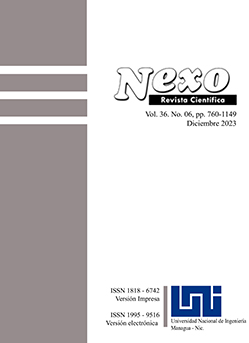Analysis fin field-effect transistor design with high-k insulators
DOI:
https://doi.org/10.5377/nexo.v36i06.17445Keywords:
High-k insulators, short circuit current, electrical and chemical sensing, improved dispersion voltage current conveyor, Field Effect Transistor, fractional oscillator, lossless isolated inductor simulator, band-pass filterAbstract
In this article, we integrate a Fin Field Effect Transistor with high-k insulators to investigate the optimal design for chemical field effect transistors in order to give higher inductance (resulting in a higher transmission relationship), improved amplitude, and outcome-based substance. pH sensing was utilised to test the design. We investigated the responsiveness and linearity of silicon dioxide, oxide, and hafnium oxide as pH-sensing electromagnetic materials, as well as their chemical resistance in various acids. The device’s huge component ratio and fin shape allow for high currents and a more dependable planar conducting channel than conventional silicon nanowires. The hafnium oxide Fin Field Effect Transistor architecture delivered the greatest results, with the most linear features of generation and turnover and a broader dynamic range. The chemical stability of hafnium oxide was also the best. As a result, we believe the large component ratio Fin Field Effect Transistors/high-k dielectric combination can provide the optimal process fairness for Field-Effect Transistor-based sensors. The authors propose a novel seamless embedded induction approximation with a quaternary resonator. Only one deleterious modified divergent voltage current conveyor, one of the suggested quaternary synthesisers, uses a Z input, a rectifier, and two crossed capacitive. In the intended unidirectional isolated circuit emulator, just one customised split electrical output feeder with a sole Z electrode, two switches, and the first neutral capacitor are used. The suggested seamless rooted circuit simulation just requires a specific passive constituent compatibility criterion. In addition, the suggested lossless grounded inductor simulator yields a ring filter application. To illustrate the performance of all the circuits, a variety of models using the LTSPICE software, the cadence virtuoso 7nm parameter, and data analyses were performed.
Downloads
Downloads
Published
How to Cite
Issue
Section
License
Copyright (c) 2024 Array

This work is licensed under a Creative Commons Attribution 4.0 International License.
The authors who publish in Nexo Scientific Journal agree to the following terms:
- Authors retain the copyright and grant the journal the right of the first publication under the license Creative Commons Attribution License https://creativecommons.org/licenses/by/3.0/, which allows others to share the work with a recognition of the authorship of the work and the initial publication in Nexo Scientific Journal.
- Authors may separately establish additional agreements for the non-exclusive distribution of the version of the work published in the journal (for example, in an institutional repository or a book), with the recognition of the initial publication in Nexo Scientific Journal.
- Authors are allowed and encouraged to disseminate their works electronically (for example, in institutional repositories or in their own website) before and during the submission process, as it can lead to productive exchanges, as well as earlier and greater citation of published works.











